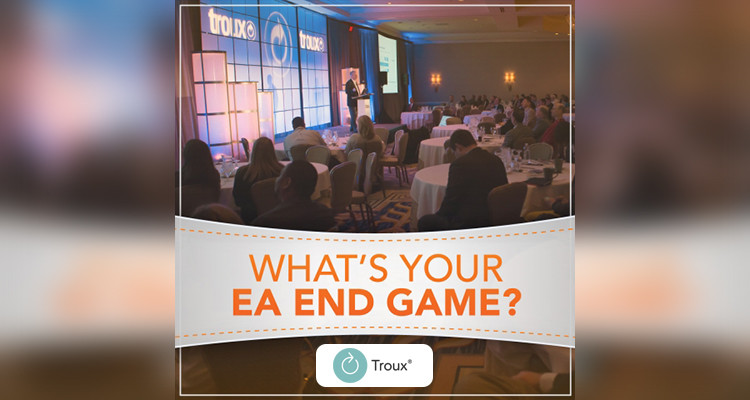
A couple weeks ago we held our annual Troux Worldwide Conference, inviting customers and partners from across the country and even the world to meet us in our hometown of Austin, TX. We hosted customers from healthcare to banking, from public sector to consumer packaged goods. Aside from the compelling conversation, fantastic food and inspiring keynotes from the likes of TED alum David McCandless, it never ceases to amaze me what our customers are able to achieve through enterprise intelligence and EA toolsets. That’s the spirit of the conference – to help customers learn from the innovative approaches of their peers and to get the synapses firing on how they can transform their businesses through EI.
Basic transparency into a company’s IT operations, resources and processes is a victory, albeit one that should really be a given. It’s when more direct business value or tangible results can be derived from enterprise intelligence that EA becomes especially formidable and invigorating. You do need to have a clear goal of what you want to get out of an EA program, but the possibilities are figuratively endless.
Is your implementation a straightforward costing-cutting effort or an exercise to simplify your business model? Is it linked to business capability planning? Does it have to do with any of the extensive subset of application portfolio management outcomes, which include the creation of shared services, analyzing which apps are prime for cloud migration, shoring up cybersecurity through asset management, or reconciling shadow IT and standards? The list of possible outcomes goes on, but business leaders need to be able to see demonstrable results and understand exactly what they’re getting out of enterprise intelligence. Quite a few of the customers that presented at TWC have figured out how to tell their EA story in a way that resonates.
Consider Wells Fargo’s Consumer Lending Group, which has begun its EA journey by thinking big and having the courage to change, while starting small in an endeavor to bring shadow IT back under the appropriate umbrella. To date, they’ve been able to streamline, eliminate redundancies, consolidate and cut costs associated with over 250 standardized business functions, more than 2200 business processes and about one-fifth of 5000 existing apps. That’s a heck of a lot more value than just basic IT transparency.
Or take Devon Energy Corporation. Using EI, the company smoothly integrated 27 corporate acquisitions and was able to enforce data stewardship, going from just 1 percent of data being complete to 85 percent complete in only two months. In a sector that’s changing as rapidly as oil and gas, where prices and market factors soar and dive at the drop of a hat, it thrills us to know that enterprise intelligence can help Devon evaluate next steps for the business every single day.
Or how about Moffitt Cancer Center, where a core team of architects leveraged enterprise intelligence to evaluate a migration of key applications to the public cloud. Some of those apps and processes audit personal health info in a matter of hours rather than days or weeks, preventing black market insurance fraud. Talk about being critical and needing to know that they will absolutely work.
And last but certainly not least, our Troux Innovation Award winner: The U.S. Department of Energy, represented by Chief Enterprise Architect Rick Lauderdale. As another TWC guest Jason Bloomberg outlined in his article, The Cybersecurity Risk That Dwarfs All Others, “[Lauderdale] helped the DOE transform the way they dealt with the risks inherent in obsolete software…Connecting the dots between IT asset management, cybersecurity, enterprise architecture, and the operationalization of IT information is a tall order, but is an increasingly familiar enabler of business agility.” Lauderdale not only revamped an application portfolio and increased cybersecurity, but he helped the DoE cut costs and is actively working on transferring the model to more than 10 other federal government agencies. Again, that’s serious impact.
Trust me when I say that these are just a few of the brilliant examples shared at TWC. You’ll see more on all of these customer programs over the rest of this year as their strategies and execution unfold. In some cases they’re just getting started on producing real change for the business, but they all prove one critical point. In order to see true value from enterprise intelligence, start by asking yourself, “What’s my EA end game?”




